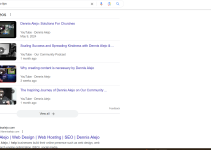In the ever-evolving landscape of SEO, internal linking stands out as a powerful tool to enhance your website's visibility and user experience. Understanding what internal linking is, how to implement it effectively, and devising a strategic action plan are key components in elevating your website's performance. Let's delve into the intricacies of internal linking to unlock its full potential.
What is Internal Linking? Internal linking is the practice of connecting one page of a website to another through hyperlinks. These links help users navigate between different pages on your site and also contribute to how search engines understand the structure and hierarchy of your content. Essentially, internal links create a network within your website, allowing both users and search engines to explore and discover relevant information seamlessly.
How to Implement Internal Linking Effectively: A Step-by-Step Guide
- Understand Your Site Structure: Before diving into internal linking, have a clear understanding of your website's structure. Identify cornerstone content, key landing pages, and the hierarchy of information. This forms the foundation for a strategic internal linking strategy.
- Identify Relevant Anchor Text: Anchor text, the clickable text in a hyperlink, plays a crucial role in internal linking. Use descriptive and relevant anchor text that provides users and search engines with a clear idea of the linked content. Avoid generic phrases like “click here” and opt for anchor text that reflects the content's topic.
- Prioritize Relevance: Internal links should be contextually relevant to the content they are embedded in. The goal is to guide users to related or additional information that complements the current page. This not only enhances the user experience but also signals to search engines that your content is interconnected and comprehensive.
- Implement a Hierarchical Structure: Organize your internal links in a hierarchical manner. Important pages, such as your homepage and cornerstone content, should have more internal links pointing to them. This hierarchical structure helps search engines understand the significance of different pages on your site.
- Utilize Breadcrumbs: Breadcrumbs, a navigational aid typically displayed at the top of a page, serve as a visual representation of a page's location within the site's structure. Implementing breadcrumbs not only enhances user navigation but also creates additional internal links.
- Strategic Use of Dofollow and Nofollow Links: While most internal links should be set as “dofollow” to pass authority, there might be instances where you want to use “nofollow” links. This is particularly relevant for links to pages like privacy policies or login pages, where you may not want to transfer SEO authority.
Your Action Plan for Internal Linking Mastery:
- Conduct a Website Audit: Begin by auditing your website's current internal linking structure. Identify pages with low or no internal links and assess the overall coherence of your internal linking network.
- Create a Linking Strategy: Develop a comprehensive internal linking strategy based on your website audit. Identify key pages that require more internal links, prioritize cornerstone content, and plan the distribution of links throughout your site.
- Update Anchor Texts: Review and update anchor texts to ensure they are descriptive and relevant. Optimize anchor texts to align with your SEO goals and the overall user experience.
- Implement Breadcrumbs: If you haven't already, consider implementing breadcrumbs to provide users and search engines with a clear path of navigation. Breadcrumbs contribute to a more organized and user-friendly site structure.
- Monitor and Adapt: Regularly monitor the performance of your internal linking strategy. Utilize tools like Google Analytics to assess user engagement, page views, and the effectiveness of your internal links. Adapt your strategy based on data-driven insights.
- Seek Professional Assistance: For a more in-depth and tailored internal linking strategy, consider seeking assistance from SEO experts. Companies like Instant Web Tools, LLC specialize in optimizing website performance, including internal linking strategies that align with SEO best practices.
In conclusion, mastering internal linking is a fundamental aspect of SEO that can significantly impact your website's visibility and user experience. By understanding the intricacies of internal linking, implementing it effectively, and devising a strategic action plan, you pave the way for improved search engine rankings and a more cohesive website structure. Elevate your internal linking game and unlock the full potential of your website's SEO prowess. Subscribe to dennis.tips for ongoing insights and stay ahead in the dynamic world of digital success.





